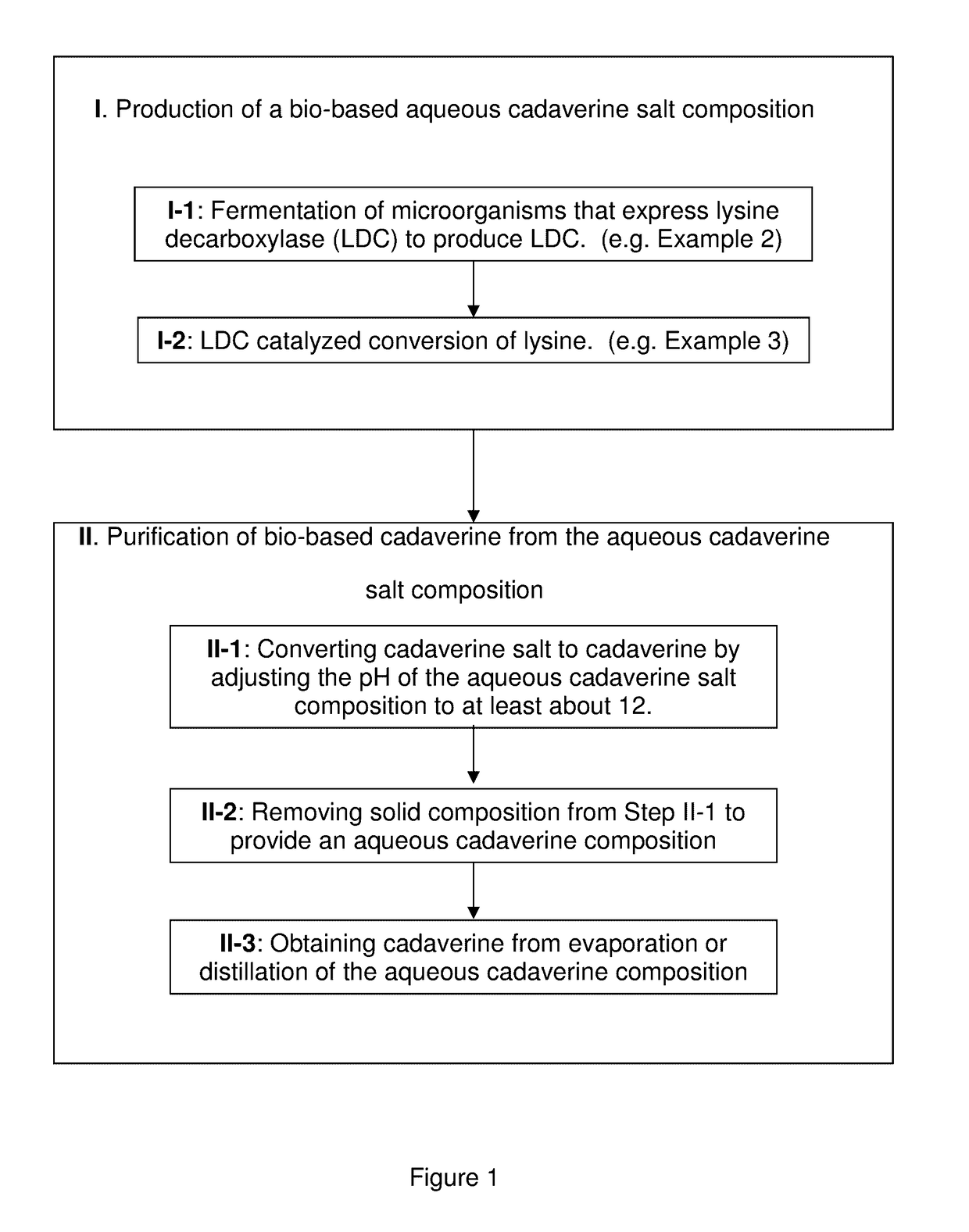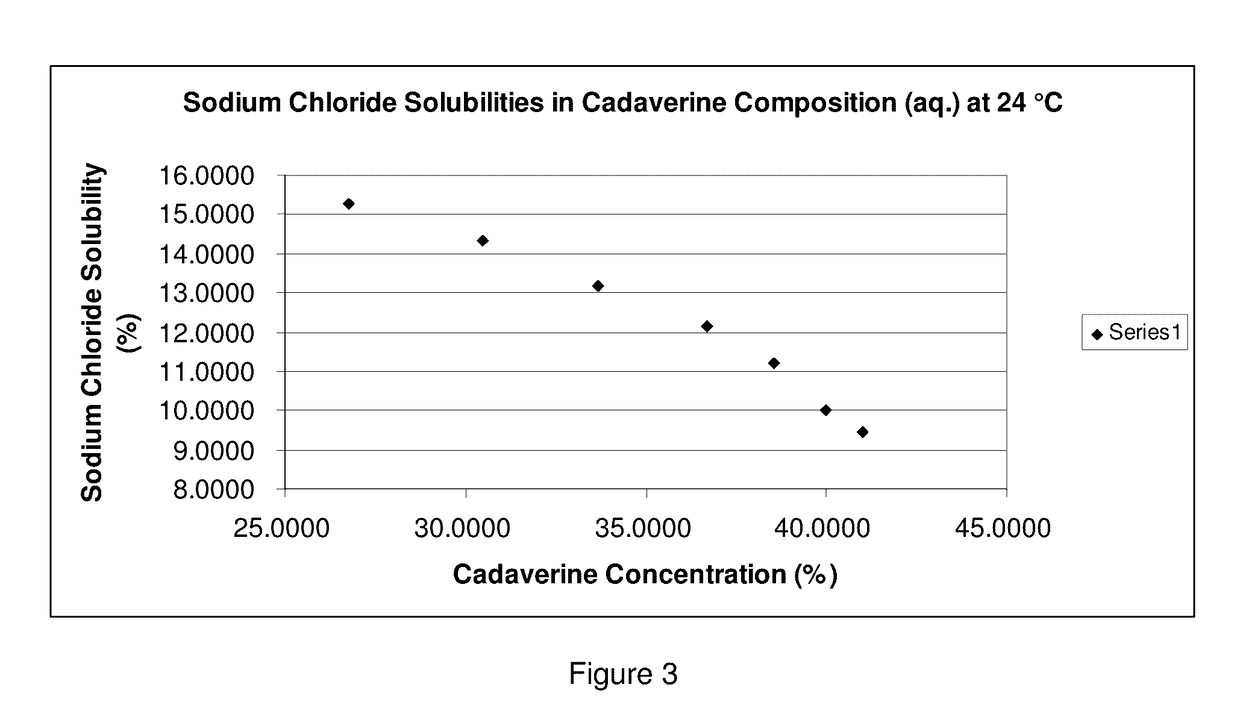Preparation of cadaverine
a cadaverine and evaporation technology, applied in the direction of amino compound purification/separation, etc., can solve the problems of toxic organic solvents, undesired contamination of bio-based cadaverine, etc., and achieve the effect of less production costs, easy heating, and convenient evaporation/distillation
- Summary
- Abstract
- Description
- Claims
- Application Information
AI Technical Summary
Benefits of technology
Problems solved by technology
Method used
Image
Examples
example 1
Preparation of a Lysine Fermentation Broth
(1) LB Medium Slants:
[0142]LB medium slants were prepared using LB medium containing tryptone 1%, yeast extract 0.5%, and NaCl 1%, pH 7.2.
(2) Primary Seed Culture Medium (Shake Flask Seed Culture Medium)
[0143]A Corynebacterium culture expressing lysine was grown on the LB medium slants, and transferred into a 500 mL seed flask containing the 200 mL liquid medium (liquid broth medium containing beef extract 1%, tryptone 1%, yeast extract 0.5%, and NaCl 0.5%, pH 7.0), then cultured at 33° C. on 200 rmp shaking bed for 10-15 hours.
(3) Lysine Fermentation
[0144]A fermentation medium (5 L) was added to a 10 L fermentor. Then the seed liquid prepared above was transferred into the fermentor for fermentation. The fermentation medium contained: glucose 1.5%, molasses 0.2%, corn steep liquor 0.06%, soybean meal hydrolysate 0.05%, ammonium sulfate 0.2%, dipotassium hydrogen phosphate 0.01%, and magnesium sulfate 0.005%. After sterilization at 121° C. f...
example 2
Preparation of Lysine Decarboxylase (LDC)
(1) Seeds and Fermentation Medium:
[0146]Seed culture medium (g / L): Tryptone 10, beef extract 5, NaCl 5, corn steep liquor, 5, pH 7.2. A wild Hafnia alvei strain (Hafnia alvei 1.1009 from CGMCC, http: / / www.cgmcc.net / index.php / Contents / show / id / 460) expressing LDC was grown on slant, transferred to a triangle flask containing 30 mL seed medium, and cultured at 35° C. with shaking at 170 R / min for 15 hours.
(2) Culture Conditions
[0147]Fermentation medium (g / L): glucose 18, yeast extract 20, corn steep liquor 36.6, MgSO4 0.3, KH2PO4 0.1, NaCl 3, L-lysine 5, vitamin B6 1, and pH 6.5-7.0.
[0148]10% seed was transferred into a 250 mL flask containing 100 mL fermentation medium. In the cell growth phase, the temperature was controlled at 35° C. and the cells were cultured on a rotary shaker 200 r / min oscillation for 13 hours; then cultured statically for 5 hours. The obtained LDC fermentation broth was used directly in LDC catalyzed conversion of lysine...
example 3
LDC Catalyzed Conversion of Lysine
(1) Enzymatic Conversion of Lysine Hydrochloride
[0149]100 L LDC fermentation broth (Example 2) was added in a 250 L reactor, acetic acid and sodium acetate were added to the reaction to final molar concentrations of 0.2 mol / L, respectively. Commercially available lysine hydrochloride was added to the reaction to control the lysine concentration at 3 g / L, and Tween-80 (total 0.15 kg) was added to the reaction. The reaction was stirred at 35° C. The reaction was complete within about 5 hours, with a lysine molar conversion rate of about 98%. The enzymatic conversion solution was concentrated to obtain a cadaverine salt solution (about 5%), which was ready for optional further processing.
(2) Enzymatic Conversion of Lysine Sulfate
[0150]100 L LDC fermentation broth (Example 2) was added in a 250 L reactor, acetic acid and sodium acetate were added to the reaction to final molar concentrations of 0.2 mol / L, respectively. Commercially available lysine sulf...
PUM
| Property | Measurement | Unit |
|---|---|---|
| temperature | aaaaa | aaaaa |
| temperature | aaaaa | aaaaa |
| temperature | aaaaa | aaaaa |
Abstract
Description
Claims
Application Information
 Login to View More
Login to View More - R&D
- Intellectual Property
- Life Sciences
- Materials
- Tech Scout
- Unparalleled Data Quality
- Higher Quality Content
- 60% Fewer Hallucinations
Browse by: Latest US Patents, China's latest patents, Technical Efficacy Thesaurus, Application Domain, Technology Topic, Popular Technical Reports.
© 2025 PatSnap. All rights reserved.Legal|Privacy policy|Modern Slavery Act Transparency Statement|Sitemap|About US| Contact US: help@patsnap.com



